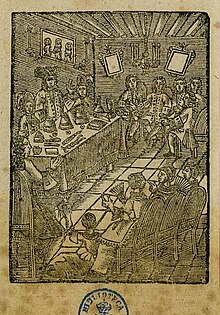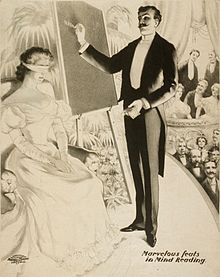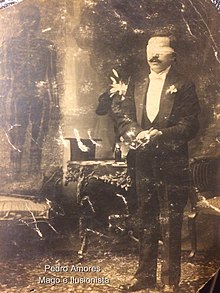Illusionism
Illusionism, popularly called magic, is a scenic, subjective, narrative art and a show of skill and ingenuity, which consists of artificially producing effects that are apparently wonderful and inexplicable. while the cause that produces them is unknown. These effects (disappearances, transformations, unions, mind readings, etc.), which pretend to make the impossible appear to be a reality, are known as effects, sleight of hand, illusions, and vulgarly as magic tricks.
There is room for various specialties within magic: fantasists, conjurers, prestidigitators, card magicians, mentalists, tricksters and kings of evasion with or without ties, who protect their tricks with the commitment of professional secrecy.
History
Known under the various names of simulated magic, white magic or scamoteo, illusionism dates back to the most distant antiquity.
The first written and documented data on magic come from Egypt, more than 4000 years ago. A drawing on the wall of a burial chamber in the city of Beni Hassan—probably dated 2,200 years BC—represents two men performing what appears to be an illusion trick with goblet-shaped bowls. The hieroglyphics that indicate exit from below give the impression of confirming that a ball or some small round object is found under one of the vessels, about to appear magically.
Henry Westcar, a British adventurer, discovered the Westcar Papyrus in 1825, the first document describing a magical function performed by the magician Djedi at the royal court of Khufu (Chufu). The papyrus illustrates the unique and special status enjoyed by the art of illusionism. According to that text, Djedi was a legend among men. He was credited with one hundred and ten years of age and appetites that rivaled the gods. The mere presence of him inspired fear in ordinary men. Even the omnipotent Pharaoh requested that he appear before him.
The stage is the great stone palace of Menfis, residence Keops. Slowly, but with great dignity, Dedi walks firmly radiating respect. He's old. When he comes to the throne where Keops is, it is the Pharaoh who bows. The pharaoh asks about the powers of the magician, able to reconnect the body to the cut head, and the magician answers that his powers are limited to animals. The pharaoh orders a goose to the illusionist. Dyedi takes the animal, caresses him to reassure him, draws a knife from under his robe, cuts the bird's head, and places it in the palm of his hand, so that the Pharaoh sees it. As the pharaoh watches carefully, Dyedi puts his head back on the neck of the goose, murmurs a magical invocation, shakes the goose and places it on the ground. The pharaoh desorbits his eyes when the goose gets lost, fixes the feathers and walks slowly. Dgedi repeats the experiment with other animals, and when he has finished his performance, he retires.
There are testimonies of its nomadic and carnival activity in 10th century manuscripts and among its first great specialists are the master Gonin (late 16th century), founder of a dynasty of magicians.
Assimilated to men of science, they used automata and other artifacts before the s. XVIII incorporated electricity and other scientific advances to expand their repertoire of tricks, which they presented under the name of physics and from which recreational physics was born. The consolidation of this profession occurred in the s. XVIII, giving rise to the appearance of magic theaters (Robertson, Robert-Houdin). At first, the repertoire was reduced above all to scamoteo (make an object disappear to find it in a different place than the one where it should be or make another appear in its place), but it was later expanded with complex tricks of great magic.
The most celebrated magician and escape artist of the 19th century (and possibly of all time) was Harry Houdini (1874-1926), taking his professional name from Harry Keller and the aforementioned Robert-Houdin, and developing a series of illusions of stage magic, many of them based on the art of escape.
At the end of the 20th century, illusionism once again rose to prominence thanks to first Doug Henning, and later David Copperfield, through their television specials, Broadway shows and international tours.
Classical Illusionists

- Matthias Buchinger (1674 – 1740)
- Isaac Fawkes (1675? – 1732)
- Alessandro Cagliostro (1743 – 1795)
- Étienne-Gaspard Robert, "Robertson" (1763 – 1837)
- Bartolomeo Bosco (1793 - 1863)
- Jean Eugène Robert-Houdin (1805 – 1871)
- Johann Nepomuk Hofzinser (1806 – 1875)
- John Henry Anderson (1814 - 1874)
- Fructuoso Canonge (1824 – 1890)
- Fox Sisters
- Davenport brothers
- Marius Cazeneuve (1839 - 1913)
- John Nevil Maskelyne (1839 – 1917)
- Carl Herrmann (1816 - 1887)
- Alexander Herrmann (1844 - 1896)
- Adelaide Herrmann (1853 – 1932)
- Buatier de Kolta (1845 - 1903)
- Joaquín Partagás (1848 – 1931)
- Harry Kellar (1849 - 1922)
- Ching Ling Foo (1854 - 1922)
- Washington Irving Bishop (1855 - 1889)
- Chung Ling Soo (1861 – 1918)
- Georges Méliès (1861 – 1938)
- Servais Le Roy (1865 - 1953)
- Thomas Nelson Downs (1867-1938)
- David Devant (1868 - 1941)
- Howard Thurston (1869 – 1936)
- Sigmund Neuberger, "the Great Lafayette" (1871 – 1911)
- Nate Leipzig (1873 - 1939)
- Horace Goldin (1873 - 1939)
- Max Malini (1873 - 1942)
- Harry Houdini (1874 – 1926)
- Tobias Bamberg, "Okito" (1875 – 1963)
- W. C. Fields (1880 – 1946)
- P. T. Selbit (1881 - 1938)
- Carmo (1881 - 1944)
- Harry August Jansen, "Dante" (1883 – 1955)
- Harry Blackstone Mr. (1885 - 1965)
- Juan José Pablo Jesorum, "Chang" (1889 – 1972)
- Harlan Tarbell (1890 – 1960)
- Dai Vernon (1894 - 1992)
- Richard Valentine Pitchford, "Cardini" (1895 – 1973)
- Wenceslao Ciuró (1895 – 1978)
- Tony Slydini (1901 - 1991)
- David Bamberg, "Fu-Manchu" (1904 – 1974)
- Theodore Annemann (1907 – 1942)
- Al Koran (1914 - 1972)
Modern Illusionists
- Ali Bongo (1929 - 2009)
- Antonio Díaz
- Arturo de Ascanio (1929 - 1997)
- Channing Pollock (1926 - 2006)
- Criss Angel
- Dani DaOrtiz
- David Blaine
- David Copperfield
- David Stone
- David Williamson
- Derek DelGaudio
- Derren Brown
- Doug Henning (1947 - 2000)
- Dynamo
- Fantasio (Ricardo Roucau) (1936 - 2017)
- Fred Kaps (1926 - 1980)
- Harry Lorayne
- Jean François Gerault
- Jeff McBride
- Jorge Blass
- Juan Tamariz
- Lance Burton
- Luis de Matos
- Luis Piedrahita
- Mago Chen Kai (1939 - 2019)
- Mark Wilson (1929 - 2021)
- Michael Ammar
- Norbert Ferré
- Paul Daniels (1938 - 2016)
- Penn " Teller "
- Pepe Carroll (1957 - 2004)
- René Lavand (1928 - 2015)
- Richiardi Jr. (1923 - 1985)
- Ricky Jay (1946 - 2018)
- Siegfried " Roy
- The Pendragons
- Tommy Wonder (1953 - 2006)
- Topics
The pattern of illusionists
Saint John Bosco (1815-1888) is the patron saint of illusionists. It was the same magicians who in 1953, at the II National Congress organized by the Spanish Society of Illusionism and held in Segovia (Spain), designated him as patron saint of magicians and illusionists, and chose him as a model and protector.
Don Bosco, as he is traditionally known, was a modern priest, close to the poorest youth, who knew how to win their friendship with techniques inspired by illusionism, thus managing to prevent many from going to jail and taking in his life the good path.
International Illusionist Day
As in every profession there is a day in the year to celebrate the exercise of it, for magic it is January 31, the feast of San Juan Bosco, international day of the magician. In addition, the International Federation of Magical Societies (FISM) agreed in 2021 to establish September 2 as the international day for the promotion of magic "Magic World Day", commemorating the day the federation was founded. In North America it is also celebrated on 31 October, National Magic Day, the date on which the death of Harry Houdini is commemorated.
Disciplines of Illusionism
Illusionism is usually classified according to different concepts depending on the distance to the spectators, number of them and location of the presentation:
- Near magic or micromagia: short-distance effects, less than a dozen spectators (some magicians use giant screens to represent them before an entire theater). They are used almost always cards, coins and other everyday and small objects. It is also known as ♪. At the global level, we can name Juan Tamariz, Dai Vernon, Martin Nash, Tony Slydini and René Lavand, among those most recognized by their colleagues.
- Ballroom magic: visible magic games for a group that can go from about 15 to 100 people. Among other elements, ropes, handkerchiefs, hoops and various medium-sized accessories are used. It is the one that usually uses magicians at parties and events.
- Scene magic: takes place on a stage, mostly in a theater. It develops the great illusions and manipulations. Cardini, Fred Kaps and Channing Pollock were outstanding in the twentieth century, among others.
- Street magic: it is done on the street. It has many centuries of history, and its most modern exponent is Jeff Sheridan, who acted in the 1970s in New York Central Park. Jim Cellini, a Slydini student, is also a renowned street magician. Street magic is not considered, by itself, a discipline within illusionism. Sometimes this confusion occurs, but in reality it is magic of close or living room, adapted to be made in an environment like the street (where it is usually standing and surrounded by the public), although the effects are the same.
Depending on the objects used:
- Numismagia: magic with coins.
- Cartomagia: magic with cards.
- Magic with animals: appearance, disappearance or transformation of pigeons, rabbits and other animals.
- Great illusions: magic in which people are cut, crossed, enclosed in narrow places, levitate, appear and disappear, etc.
Among the objects that have been most commonly used to perform magic, the following stand out: playing cards, coins, animals (doves and turtledoves, rabbits, birds,...), rings and rings, needles, rings, canes, bills, balls, light bulbs, bottles, cigarettes, ties, beakers, cubes, strings, dice, thimbles, discs, swords and knives, sponges (in the form of balls and figures), flowers, fruits and vegetables, fire, balloons, rubber bands, threads, eggs, smoke, safety pins, milk and other liquids, knives, sticks, handkerchiefs, papers and newspapers, umbrellas, blackboards, watches, mobile phones, tubes, wands, glasses and goblets, candles, dresses... in addition to the devices used in the great illusions: cabinets, trunks, boxes, cages, curtains, etc. For escapism, ropes, chains, handcuffs, straitjackets, padlocks and locks, etc. are also often used. and pulleys to lift the illusionist into the air.
Depending on effect types:
- Comic magic: As its name indicates, it is the branch in which it attaches special importance to humor and comedy.
- Prestidging, and/or manipulation: It is the branch of magic in which the secret is based on skill of hands and non-truncated objects. It differs from the prestidigitation that is more focused on ♪. It is also called manipulation of hand skill games, such as throwing a letter into the air and attacking it.
- Mentalism: It is the branch of illusionism in which the power of the mind is supposedly used. Its effects are usually predictions, divinations, reading of the mind (telepathy), telekinesis, memoristic skills, suggestion, etc. In Spain the greatest exponents of this branch of illusionism are Anthony Blake and José Carlos El Sexto Sentido. In Colombia, the mentalist and hypnotizer Richard Taylor.
- Stage manipulation: It consists of the appearance, disappearance and multiplication of objects such as balls, cards, cigarettes, CDs, etc., based mainly on the skill of the hands of the illusionist.
- Escape: It is the branch of magic in which the main objective is to escape or get rid of somewhere, or get rid of bonds and chains. They can be illusions or real escapes.
- Pickpocketing: The carterist magician must possess the ability not only manual, but verbal and gestual in order to distract his victim while "robating" him without being aware of it. For this they use many techniques, highlighting distraction, to show their art. The most common objects when stealing from a pickpocketing show are: watches, wallets, ties, belts, glasses, handkerchiefs, mobile phones... that is, any object that can be worn in the pockets of both the jacket or shirt, and the pants. Usually, this type of demonstrations are usually comical and stage-made, so the object is returned to the alleged victim at the end of the number.
- Quick Change: Discipline consisting of rapidly changing costumes in a fraction of a second.
Effect Types
The illusionist performs an effect that the viewer perceives as wonderful, contrary to natural laws or common sense, and whose cause seems unknown and inexplicable. Among the possible magical effects that can be performed are:
- Production: Make something of nothing appear.
- Disappearance: To vanish something, someone or self.
- Transformation: Transform something into something else, or change your color, shape, size, etc.
- Restoration: Restore something broken or damaged.
- Teletransportation: Transport something from one place to another, in an impossible way.
- Transposition: Exchange two or more objects of place, in an impossible way.
- Penetration: Crossing a solid object with another, without breaking it, in an impossible way.
- Multiplication: Split an object into several complete objects similar to the original. Liquids can also be multiplied, significantly increasing their quantity.
- Sympathy: Achieving that the effect caused to an object is applied to another different object
- Syntropy: Make the order appear where there is supposed to be disorder.
- Coincidence: Make coincidences that are supposed to be extremely difficult if they happen by chance.
- Prediction or Precognition: To record an event before it takes place and to check that it is fulfilled.
- Clairvoyance: Discover a secret truth or find something that is hidden, alleging supposed mental powers or a certain extrasensory perception ability. At times, supposedly magical gadgets are used (e.g. glass ball). A particular case is psychometry, or ability to get information about an object by touching it. Another particular case is radiestesia, or ability to locate hidden objects using a simple instrument (e.g. pendulum, rod, fork, etc.).
- Adivination: Similar to Clairvoyance, but claiming an extraordinary ability to interpret certain signs and evidence (often it is alleged to have a view, hearing or superior smell). For example, the illusionist can say that he guessed where something is recognizing the face expression of the spectator, listening to his breathing or his beats, perceived the trace or smell left by an object, discerning between two seemingly equal sounds,... A particular case is cumberlandism or "muscular reading": the ability to guess a person's thoughts (e.g. where he hid an object) by touching his skin, through subtle unconscious muscle movements (see ideomotor effect).
- Revelation: To manifest a secret or hidden truth through magical elements that discover it (e.g. ash, fire,...). A particular case is the cartomance, or divination through the cards (as in the Tarot).
- Telepathy: Transmission of thought between two people. Ability to "hear" the thoughts of another, or to talk to him mentally.
- Subliminal persuasion or mental manipulation: Mentally control other people without being aware, to influence their decisions.
- Hypnosis: By suggestion, take another person to a state of unconsciousness close to sleep until they get the submission of the will of the individual to the orders of the illusionist.
- Telequinesis: Move objects with the mind (or crush them, manipulate them...) without touching them.
- Levitation: Suspend something in the air simulating absence of gravity, no support point.
- Suspension: Similar to levitation, but maintaining a support point.
- Psychokinesis: Deformation or alteration of objects by means of mental powers, for example bending the metal or turning a rigid object (unlike telekinesis, here you can touch the object).
- Animation: Achieve the appearance of life to inanimate objects.
- Piroquinesis: Make objects warm, even burning, by mere contact with our hands or view.
- Crioquinesis: Make objects cool, even freeze, by mere contact with our hands or view.
- Escape: Free yourself from any element that prevents free movement. Sometimes this becomes counterreloj, exposing the magician to a serious danger if he does not get free on time.
- Invulnerability: Demonstrate the ability to resist harmful or fatal events, or to heal wounds astonishingly.
- Intangibility: Ability to be crossed by a solid object (e.g. a sword) without suffering any kind of damage. Sometimes it is simulated that the body is cut, separated and then recomposed without any harm.
- Bilocation: Being in different places at the same time.
Related arts that departed from illusionism
- Fakirismo
- Ventriloquia
- Chinese shadows
- Black Theatre of Prague
- Theatrical hypothesis
- Globoflexia
- Flowers with cards (Cardistry)
Some classic games
- Disappearing a tissue
- Zig Zag
- Metamorphosis
- Disappearance of a rabbit
- Apparition of a rose
- Disappearance of the Statue of Liberty
- Crossing the Chinese Wall
- Wrought woman
- Origami trick
- Trick of cups and balls
- Assembly of aces
Contenido relacionado
Amy reads
Thomas Gainsborough
Raoul Dufy






